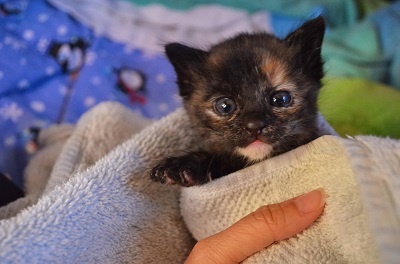 For the past 3 years, Stayin' Alive Long Beach has been advocating for a foster program at LBACS. We were repeatedly told it couldn't be done. A mere 19 months ago, LBACS manager Ted Stevens stated in a local newspaper article that Stayin' Alive's suggestion that LBACS implement a foster program for cats was too expensive and “unrealistic.” After years of saying it couldn't be done, and after thousands of kittens have found death at the end of a syringe filled with sodium pentobarbital, it appears it CAN be done after all. Let us be clear. We're thrilled to see that LBACS is seeking fosters this kitten season. If this is an actual change in policy and not a one-shot deal, we are overjoyed to hear it. But we'll remain cautiously optimistic for two reasons. One is that nothing that Mr. Stevens has said or done in the past three years has indicated that he is truly interested in doing the hard work and providing the leadership necessary to significantly decrease the kill rate at the LBACS animal shelter. In fact, the vehemence with which he has fought No Kill has been singularly impressive, and it will take time to believe that he is genuinely interested in decreasing his shelter's kill rate. The second is that we have always said and will continue to say that until an adoption program, foster program and other essential lifesaving programs are codified in Long Beach city ordinance, our shelter animals will continue to be at the mercy of whoever is running LBACS. If we want a sustainable No Kill shelter, one that has lifesaving programs in place for decades to come, regardless of who comes and goes in positions of power at LBACS, it will require an actual ordinance that requires LBACS to put those in place. So far, City Council has not been interested in taking action – they will need to continue to hear from you – the public – that the killing of nearly 1500 kittens per year in our city's animal shelter is not acceptable. This is good news, but it's only a beginning. We'll continue to watch and advocate for better and more efficient lifesaving programs at the Long Beach animal shelter. But for tonight, we're celebrating....for the kitties' sake.
1 Comment
 LBACS' newest so-called solution to the animal homelessness problem in Long Beach consists of transporting shelter animals thousands of miles away out of Long Beach by plane to cities in states that supposedly need more animals to adopt out. We often wonder how it is remotely possible that Long Beach animals aren't displacing needy animals in those other communities. And we wonder why it would be more desirable to put animals through a long, stressful plane trip rather than take them to a local adoption event to be adopted in our off-the-charts animal-loving city of more than half a million people. Here's the perspective of some of the folks in these receiving communities. "While Greenhill continues to turn away animals that are already living here; they keep importing dogs from California. No doubt these dog deliveries are planned, and they have to empty the kennel in preparation, keeping empty kennels unoccupied for who knows how long. Today Greenhill Road has 21 dogs. Eighteen of those dogs are imports. EIGHTEEN OF TWENTY-ONE. While I do not begrudge these dogs homes, by being able to continually export dogs, this keeps California from cleaning up its own mess, and deprives dogs already living here of assistance. If Greenhill were meeting the needs of animals already here in this community, then helping dogs from elsewhere would be more appropriate." The fact is, it's easier to pass the buck to another city or state and expect others to do the work that is needed to save our community's animals. But that doesn't make it acceptable. We agree with the writer above - we don't begrudge the animals these homes, but there are more efficient, less expensive and less stressful ways to place animals in home locally, and that should be our animal shelter's Job 1. Especially if by sending our animals out, we're condemning other communities' animals to death. Read more here: https://www.facebook.com/NoKillLaneCounty/posts/850824274991747  Three Years and Thousands of Lost Lives Later Back in 2012, we sent the manager of LBACS several suggestions for increasing the number of volunteers at LBACS and thus make it possible for additional programs, such as offsite adoptions and a foster program, to be put in place. They were ignored. We met with the manager, Ted Stevens, a year later, and were told that volunteers could be difficult to manage -- in other words, more trouble than they were worth. That year, LBACS had only 28 volunteers according to LBACS records obtained under the California Public Records Act. Since that time, the suggestions have also been available on our website, and we hoped that LBACS would avail themselves of them. We just checked suggestion #5 and see that 3 years and thousands of lost lives later, LBACS has finally implemented it. Becoming an animal shelter that consistently saves 90%+ of its animals doesn't happen by giving lip service to programs. It doesn't happen by implementing programs in a piecemeal fashion, here and there, hoping that the community will take up the slack. It's the shelter management that MUST provide the leadership and the vision to save the animals and to do so in an efficient and cost-effective way. We hope that LBACS has changed its attitude about volunteers. In the news article covering the recent community meeting about volunteers, Mr. Stevens said that he would like a base of 100-150 volunteers. We can't help but notice that this change came about after we spoke at City Council last August, pointing out that Sacramento had logged over 36,000 volunteer hours the previous year, whereas Long Beach had logged only 2300. We are thrilled that LBACS now has a goal, where goals were never mentioned before, of over 100 volunteers. If the amazing goodwill and energy of Long Beach's animal-loving community are properly directed toward effective lifesaving programs, there is no doubt that Long Beach can become a No Kill city. We encourage people to volunteer at the city animal shelter. If they are allowed to do what is needed, they will play an absolutely VITAL role in saving the 90+% of animals at the shelter that CAN be saved. But we think it's important for people to know the history of how this came about and to know that advocacy works. Citizens speaking out to change the system -- a very broken system that has been in place for a very long time -- is the only way that we will make key and sustainable changes in the way our animal shelter is run. LBACS still doesn't have a strong adoption program, nor does it have a strong foster program. It's clear that advocacy on behalf of the shelter animals to reform LBACS policies is still needed. We'll continue to advocate for the shelter animals in Long Beach. We need a shelter where no healthy or treatable animal dies in our city shelter. And we don't have that yet.  Last week, Long Beach Animal Care Services attended a community meeting about how to help homeless animals in Long Beach. We were pleased to see that LBACS attended the event and spoke about the need for volunteers at the Long Beach animal shelter. We at Stayin' Alive have been advocating for this for three years now, and we're happy to see this change in the way LBACS is talking about volunteers. We very much hope it will be followed up by continued efforts to publicize the need for volunteers, more frequent volunteer orientations and a streamlined process to get more volunteers on board. If LBACS is serious about getting more volunteers out at the shelter, there is no doubt that the people of Long Beach will step up and help out the shelter animals. In spite of this, we were very troubled by a number of things that LBACS said at the meeting – notably the statement by Long Beach Animal Care Services manager Ted Stevens that Long Beach is “almost No Kill,” as reported by a local newspaper. Saying Long Beach is “almost No Kill” is like saying that California is not in a drought. Long Beach is not by any reasonable measure “almost No Kill.” No Kill is defined as saving 90% or more of the animals in a shelter or community by putting in place a group of lifesaving programs, including a strong adoption program and a strong foster program. In making this grossly overstated claim, Mr. Stevens cited an 87% save rate for dogs in March and an “upper 60s mark” for cats. There are several problems with this claim that we feel the public in Long Beach needs to be aware of. The first thing to note is that “upper 60s” for cats is clearly not No Kill, so the 87% save rate for dogs was evidently what was meant by “almost No Kill.” Unfortunately for Mr. Stevens, No Kill is not defined by the save rate of one species or one age group of one species (e.g, puppies vs. dogs). ALL species must be calculated, and at a minimum, that includes, dogs, cats, kittens and puppies. When you factor in those groups, Long Beach's save rate in March was substantially lower. On a related note, we have noticed that Mr. Stevens often cites vague numbers, especially when it comes to cats. For a public servant who makes over $100,000 a year, according totransparentcalifornia.org, and received a raise in 2013, a year when the shelter killed over 5,000 animals and only adopted out 434, we think that at the very least he should know the number of animals they kill over at LBACS. However, the other problem is that it is simply inaccurate to declare “almost No Kill” based on one month's statistics. Variations from month to month in kill and save rates at animal shelters are significant and often seasonal, as they are affected by things such as holidays and the high birth rate of kittens during the spring. In October of last year, LBACS' kill rate peaked at 49% (save rate 51%). That's a whopping 36 percentage point difference between what Stevens claims and the grim reality that was taking place at LBACS just a few months ago. The only accurate way to assess the No Kill status is to set performance goals for each month, record the statistics for each month and then look at the total at the end of the year. Ideally, the shelter will make the 90%+ goal each month, but if not, the goal is to make 90%+ at the end of the year. It is disingenuous to pick out the numbers for one species – the highest save rate – for ONE month and call the shelter No Kill. For a shelter director to do so is to show a lack of knowledge of the area of sheltering that borders on incompetence, or it is done to mislead the public. Stayin' Alive Long Beach requests kennel statistics reports from LBACS every month under the California Public Records Act. Here is what the numbers tell us: 1. LBACS' kill rate for companion animals in 2014, the most recent full year for which statistics are available, was 39%. That's a 61% save rate, which is a far cry from the 90%+ goal of shelters that are genuinely committed to No Kill. Based on their own numbers, Long Beach Animal Care Services is decidedly NOT No Kill. 2. LBACS only adopted out 403 animals last year. Compare that with the more than 3,000 animals that Sacramento Animal Care Services adopts out each year. If Sacramento can do it (with a smaller budget than LBACS, we might add) Long Beach can do it, too. Instead, city administration and LBACS choose to continue killing on your behalf using your tax dollars. Calling a shelter that doesn't have a strong adoption program in place “No Kill” is to have missed the point of No Kill altogether. 3. The lion's share of improvement at LBACS over the past year has been due to two things: the first is a Shelter-Neuter-Return program that Stayin' Alive and other animal advocates had been asking that LBACS implement for at least 2 years if not longer. When it was finally implemented this past year, the program produced a significant increase in the number of feral cats saved. The other area of improvement has resulted from an increase in the number of animals that rescues have pulled from the shelter. It's worth nothing that both of these efforts are largely fueled by the efforts of people and organizations in the community who are passionate and dedicated animal advocates who, when LBACS does not stand in their way, have proven that Long Beach is capable of doing great things, including decrease the number of animals our city shelter kills. 4. In spite of these improvements, LBACS continues to invest most of its efforts in pass-the-buck policies rather than dig in and do adoptions themselves with the use of a strong volunteer program. They continue to transport small numbers of animals to cities thousands of miles away by plane to shelters that supposedly have a need for more animals – they do this when it is far more efficient and cost-effective to regularly take animals to offsite adoption events locally. LBACS is NOT No Kill, but it could easily become No Kill, if it were serious about having a strong adoption program, foster program and other animal-friendly policies and programs that have been proven to work at progressive shelters across the nation. We don't deny that the general push of this meeting was to get more volunteers, for rescue groups and for the shelter. That's good news. But we can't help but notice that LBACS doesn't mobilize unless their lack of effective policies and programs is brought to the attention to the public, hence, this post. This is not to in any way diminish the efforts that volunteers and general staff make at LBACS, or the efforts of those who organized this meeting – we know they're working hard and trying to help animals and applaud them for it, but the system, policies, programs and management at LBACS are working against them. These policies and programs need to change, and LBACS has to stop misleading the public by cherry-picking their statistics. We have talked to the Mayor about this and are very disappointed that it is continuing to happen. We will continue to report on the progress (or non-progress) of Long Beach Animal Care Services – because the people and animals of Long Beach deserve a city animal shelter that is run with integrity and transparency, and we don't have that yet. |
Archives
June 2022
SALB
An initiative to make Long Beach a No Kill community. Categories |
No Kill Long Beach
- Home
- ::NKLB in the News::
- 2020 Voter Information Guide
- How you can help
-
Get Informed
- Contact Us
- LBACS's Numbers
- Model No Kill Ordinance
- LB City Officials' Contact Info
- No Kill Long Beach Blog
- Justice for Thor
- LBACS Complaints
- A Shelter in Crisis
- 2018 Candidates' Responses
- LBACS Document Archive
- Why "Compassion Saves" is No Good
 RSS Feed
RSS Feed
